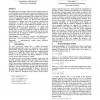21 search results - page 3 / 5 » Discriminating Animate from Inanimate Visual Stimuli |
NIPS
2000
13 years 8 months ago
2000
Stimulus arrays are inevitably presented at different positions on the retina in visual tasks, even those that nominally require fixation. In particular, this applies to many perc...
AAAI
2012
11 years 9 months ago
2012
We propose to model relative attributes1 that capture the relationships between images and objects in terms of human-nameable visual properties. For example, the models can captur...
APGV
2005
ACM
14 years 28 days ago
2005
ACM
How different are two images when viewed by a human observer? Such knowledge is needed in many situations including when one has to judge the degree to which a graphics representa...
TNN
2011
13 years 2 months ago
2011
—We investigate architectures for time encoding and time decoding of visual stimuli such as natural and synthetic video streams (movies, animation). The architecture for time enc...
NIPS
2004
13 years 8 months ago
2004
It has been demonstrated that basic aspects of human visual motion perception are qualitatively consistent with a Bayesian estimation framework, where the prior probability distri...

